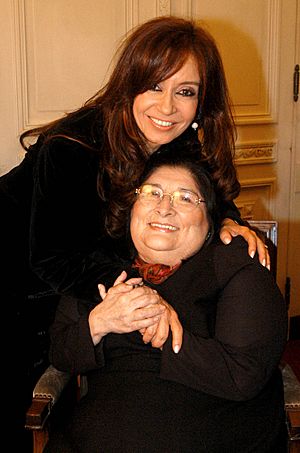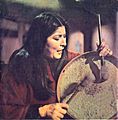Mercedes Sosa facts for kids
Quick facts for kids
Mercedes Sosa
|
|
|---|---|

Photograph of Sosa by Annemarie Heinrich
|
|
| Born |
Haydée Mercedes Sosa
9 July 1935 San Miguel de Tucumán, Tucumán, Argentina
|
| Died | 4 October 2009 (aged 74) Buenos Aires, Argentina
|
| Occupation | Singer |
| Years active | 1950–2009 |
| Musical career | |
| Genres |
|
| Instruments | Vocals |
Haydée Mercedes Sosa (born July 9, 1935 – died October 4, 2009) was a famous singer from Argentina. People often called her La Negra (which means "The Black One"). This was a loving nickname for people with darker skin in Argentina. She was very popular in Latin America and around the world.
Mercedes Sosa started with Argentine folk music. She became a leading voice in the nueva canción movement. This movement used music to share important messages. She sang songs by many Latin American writers. Her powerful music made people call her the "voice of the voiceless ones."
Sosa performed in famous places like the Lincoln Center in New York City and the Sistine Chapel in Vatican City. She also had sold-out shows at Carnegie Hall and the Roman Colosseum. Her singing career lasted for 40 years. She won six Latin Grammy awards. She also received a special Lifetime Achievement Award in 2004. Mercedes Sosa was also an ambassador for UNICEF, helping children around the world.
Contents
Life Story of Mercedes Sosa
Mercedes Sosa was born on July 9, 1935. Her birthplace was San Miguel de Tucumán in Argentina. Her family had mixed backgrounds, including French, Spanish, and Diaguita roots. Her parents supported a political movement called Peronism, which aimed to help working people. She began her singing career by performing for this group.
In 1950, when she was 15, Mercedes won a singing contest. A local radio station gave her a two-month contract. She recorded her first album, La Voz de la Zafra, in 1959. In 1965, she sang at the Cosquín Festival. Another folk singer, Jorge Cafrune, invited her to the stage. This performance made her famous across Argentina.
Mercedes Sosa and her first husband, Manuel Oscar Matus, were important in the nueva canción movement. This movement in the 1960s used music to talk about social and political issues. Her second album, Canciones con Fundamento, was a collection of Argentine folk songs.
In 1967, Sosa toured the United States and Europe. She became very successful. Over the years, she performed and recorded many songs. She sang music from all over Latin America.
In the early 1970s, Sosa worked with composer Ariel Ramírez and writer Félix Luna. They created two special albums: Cantata Sudamericana and Mujeres Argentinas (Argentine Women). In 1971, she recorded a tribute to Chilean musician Violeta Parra. This album included one of Sosa's most famous songs, Gracias a la Vida. She also helped make songs by Milton Nascimento (Brazil) and Pablo Milanés and Silvio Rodríguez (Cuba) more popular.
In 1976, a military government took power in Argentina. Life became very difficult. Mercedes Sosa and her family received threats. But she refused to leave her country for many years. In 1979, during a concert in La Plata, she was arrested on stage. Everyone at the concert was also arrested. They were released thanks to help from other countries. Since she was banned from singing in Argentina, she moved to Paris and then to Madrid.
Sosa returned to Argentina in 1982. This was just before the military government ended. She gave a series of concerts in Buenos Aires. She invited many younger singers to perform with her. A double album from these concerts quickly became a bestseller. After this, Sosa continued to tour in Argentina and other countries. She performed in places like the Lincoln Center in New York City. People called her "America's voice."
She was not in good health for much of the 1990s. But she made a big comeback in Argentina in 1998. In 1994, she sang in the Sistine Chapel in Vatican City. In 2002, she sold out both Carnegie Hall in New York and the Colosseum in Rome in the same year.
Mercedes Sosa supported political causes that aimed to help ordinary people. She was also a UNESCO Goodwill Ambassador. This meant she helped promote peace and understanding for Latin America and the Caribbean.
Throughout her 40-year career, she worked with many different artists. These included singers from folk, opera, pop, and rock music. Some famous names she collaborated with were Joan Baez, Shakira, and Sting.
In 1999, Sosa took part in a performance of Ariel Ramírez's Misa Criolla. Her song Balderrama was featured in the 2008 movie Che.
Awards and Recognition
Mercedes Sosa won several Latin Grammy awards for Best Folk Album. These were for Misa Criolla (2000), Acústico (2003), Corazón Libre (2006), Cantora 1 (2009), and Deja La Vida Volar (2011).
In 1995, the Konex Foundation in Argentina gave her the Diamond Konex Award. This is one of the most important awards in Argentina. It recognized her as the most important person in popular music in her country over the past ten years.
Her Passing
Mercedes Sosa had health problems in her later years. She was hospitalized in Buenos Aires on September 18, 2009. She passed away on October 4, 2009, at age 74. Her son, Fabián Matus, said she lived her life to the fullest. He added that she had done almost everything she wanted.
Her body was placed at the Argentine National Congress building. This allowed the public to say goodbye. The President of Argentina ordered three days of national mourning. Thousands of people came to pay their respects. She was cremated on October 5.
News reports around the world remembered her. They said she was a great singer who used her voice to fight for justice. She received three Latin Grammy nominations for her album in 2009. She won Best Folk Album about a month after she passed away.
Tributes to Mercedes Sosa
In 2019, Google Doodle celebrated Mercedes Sosa. The special doodle was shown in many countries, including Argentina, Chile, and Uruguay.
Discography
Mercedes Sosa recorded 40 albums during her career.
Studio albums
| Year | Album details |
|---|---|
| 1962 | La Voz De La Zafra
|
| 1965 | Canciones Con Fundamento
|
| 1966 | Hermano
|
| 1966 | Yo No Canto Por Cantar
|
| 1967 | Para Cantarle A Mi Gente
|
| 1968 | Con Sabor A Mercedes Sosa
|
| 1969 | Mujeres Argentinas
|
| 1970 | El Grito De La Tierra
|
| 1970 | Navidad Con Mercedes Sosa
|
| 1971 | Homenaje a Violeta Parra
|
| 1972 | Hasta La Victoria
|
| 1972 | Cantata Sudamericana
|
| 1973 | Traigo Un Pueblo En Mi Voz
|
| 1975 | A Que Florezca Mi Pueblo
|
| 1976 | En Dirección Del Viento
|
| 1977 | Mercedes Sosa Interpreta A Atahualpa Yupanqui
|
| 1979 | Serenata Para La Tierra De Uno
|
| 1981 | A Quien Doy / Cuando Me Acuerdo de Mi País
|
| 1982 | Como Un Pájaro Libre
|
| 1983 | Mercedes Sosa
|
| 1984 | ¿Será Posible El Sur?
|
| 1985 | Vengo A Ofrecer Mi Corazón
|
| 1986 | Mercedes Sosa '86
|
| 1987 | Mercedes Sosa '87
|
| 1993 | Sino
|
| 1994 | Gestos De Amor
|
| 1996 | Escondido En Mi País
|
| 1997 | Alta Fidelidad (w/Charly García)
|
| 1998 | Al Despertar
|
| 1999 | Misa Criolla
|
| 2005 | Corazón Libre
|
| 2009 | Cantora 1 (w/various artists)
|
| 2009 | Cantora 2 (w/various artists)
|
| 2011 | Censurada
|
| 2015 | Lucerito
|
EPs
| Year | EP details |
|---|---|
| 1975 | Niño De Mañana
|
Live albums
| Year | Album details |
|---|---|
| 1973 | Si Se Calla El Cantor (with Gloria Martin)
|
| 1980 | Gravado Ao Vivo No Brasil
|
| 1982 | Mercedes Sosa en Argentina
|
| 1985 | Corazón Americano (with Milton Nascimento & León Gieco)
|
| 1989 | Live in Europe
|
| 1991 | De Mí
|
| 2002 | Acústico En Vivo
|
| 2003 | Argentina Quiere Cantar (with Víctor Heredia & León Gieco)
|
| 2010 | Deja La Vida Volar (En Gira)
|
| 2014 | Angel
|
Compilation albums
| Year | Album details |
|---|---|
| 1975 | Disco De Oro
|
| 1983 | Recital
|
| 1988 | Amigos Míos
|
| 1993 | 30 Años
|
| 1995 | Oro
|
| 1997 | The Best Of Mercedes Sosa
|
| 2013 | Siempre En Ti
|
Filmography
- Güemes, la tierra en armas (1971)
- Argentinísima (1972)
- Esta es mi Argentina (1974)
- Mercedes Sosa, como un pájaro libre (1983)
- Será possible el sur: Mercedes Sosa (1985)
- Historias de Argentina en vivo (2001)
Biographies
- Mercedes Sosa, La Negra by Rodolfo Braceli (Spanish only)
- Mercedes Sosa, La Mami by Fabián Matus (Spanish only)
- Mercedes Sosa, The Voice of Hope by Anette Christensen (translated into Spanish and Portuguese)
- Mercedes Sosa, More than a Song by Anette Christensen (translated into Spanish, French, Italian, Lithuanian and Portuguese)
Images for kids
-
Sosa with Félix Luna and Ariel Ramírez (at the piano)
See also
 In Spanish: Mercedes Sosa para niños
In Spanish: Mercedes Sosa para niños









